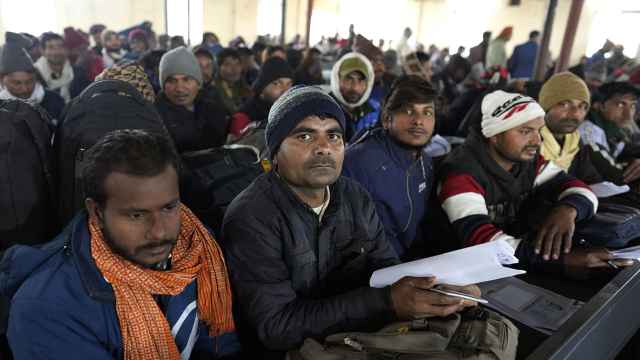HAINAN, China — Ancient Chinese architects used sweet sticky rice soup mixed with lime about 1,700 years ago to make mortar that gets stronger and stronger with time. Many of the buildings they put up are still standing today.
The emerging-market political elite were on the Chinese tropical island of Hainan last week to do some more building. But at first glance, the mortar they were using to join the BRIC members looked a lot less durable.
For most of the last decade, the BRIC countries — Brazil, Russia, India and China — were the building blocks for global growth and high investment returns. But following the international economic crisis, the game has changed: as these countries get richer, maintaining their high rates of growth is getting harder.
We are generally aware of the progress that each BRIC member has made through reform and improved terms of trade. But their ability to stick together as a group is now of greater interest as a new important factor in providing stellar returns on investment.
The economic crisis has given the reputations of all four BRIC members a major boost, and the increasingly political nature of their relations was underscored by the group summit on Hainan, to which the Friday RAM was invited as part of the Russian delegation.
The BRICS — as they must now be called since South Africa joined — are hailed as an emerging bloc, but their economies are only loosely bound together. Despite their obvious synergies, intra-BRICS trade is still only 3 percent of their total resources; the BRICS trade far more with their traditional partners than with each other, and trade and investment relations are the mortar of international relations.
The BRICS will have to find a stronger cement than talking shops on pretty islands if they are to become a real political grouping. The danger is that by enriching their citizens, domestic policy goals will inevitably clash with the global agenda of collectively increasing their clout on the world stage, and the group will splinter unless it is tightly bound together.
The BRICS have much in common, but the one feature that led Goldman Sachs to come up with the term 'BRIC' in the first place is simply their sheer size and the recognition that big countries can do things little ones can't.
Big countries with large populations produce big firms that can capitalize on economies of scale and have open access to international credit markets because their need for funds is so large. But it is the emerging middle class in these countries that makes them really attractive. The BRICS are already home to what must be the most compelling global consumer story of the coming decades: while populations vary, the nominal size of the middle class in the four BRIC countries is similar: China — 160 million, Russia — 100 million and Brazil — 75 million, with India as the surprise laggard at 30 million, but growing very fast.
The rise of the middle class, however, carries perils for BRICS governments. China and India have industrialized, but as investment and gross domestic product (GDP) have soared, consumption as a percentage of GDP fell. Now both countries are at GDP per capita levels that would argue for demand acceleration. Increasingly, however, the BRICS are rivals, and fighting for the same markets and resources is an age-old source of conflict.
As the middle class grows and the stock of borrowable ideas runs low, the rate of economic expansion will slow once per-capita incomes approach the proverbial $17,000 per year — a level that Russia and the coastal regions of China are reaching quickly. The United States sustained a long productivity boom due to its innovation prowess. Britain did it via liberalization. Emerging economies will soon have to start innovating for themselves. As the West has moved away from bricks and mortar, we ask: Will the BRICS themselves likewise create their own digital future?
At the same time, their large impoverished populations are a potential political danger. Emerging market governments face the twin imperatives of maintaining high growth rates and providing strong social support for those who are left behind in the first blush of prosperity.
Not surprisingly, as most of the BRICS have come out of the crisis triumphant, their model emphasizes state participation, heavy investment and a strong commitment by the government to supporting the lower strata of society. This model challenges neo-liberalism.
The BRICS have also seen their standing on the world stage rise. They are stepping up to the top table, and the idea of a unipolar world of America hegemony is giving way to a multi-polar one where the fastest-growing countries that are home to nearly half the globe's population will naturally play a greater role. A multilateral foreign policy is a natural stance for new world economies, but it will also be useful for determining relations within the group. The Sino-Indian relationship is one of the most strained in the world, and even during the depths of the Cold War, when the communist world faced down the capitalists, relations between the Soviet Union and China were frosty.
At the moment, these tectonic geo-political forces are driving the BRICS into each other's arms. It might lead to a reshuffle of the UN Security Council and the addition of the BRICS' currencies to the International Monetary Fund's special drawing rights basket, among other things. The next IMF/World Bank chief should be from one of the BRICs.
Almost as striking as the BRICS' similarities are their differences. Among the five members, there are centrally planned economies and democracies; resource rich and resource poor nations; nuclear and non-nuclear powers. Russia and Brazil are highly urbanized, whereas China and India are still agricultural societies with hundreds of millions living in abject poverty.
All these differences lead to very different demands on the state and will naturally lead to tensions between the BRICS. On top of this, none of the countries have any obvious affinities, as they hail from the four corners of the earth and are all culturally about as different as it's possible to be.
However, even with these differences, the BRICS are unified by the fact that no other large countries are so vulnerable to factors outside their control. Both Brazil and Russia depend on commodity markets for most of their income, whereas China, and to a lesser extent India, are dependent on external demand for their exports.
This is not a sustainable basis on which to found an economy, and it opens them up to the risks of an inherently volatile global climate while leaving them unable to do much to reduce these risks. The BRICS framework is one way to mitigate these risks as the countries work to diversify and modernize their economies, which is the only long-term antidote to these problems.
But is it really? Perhaps the only common principle uniting the BRICS is China: Is China primus inter pares? Over the last few decades, China has portrayed itself as a spokesperson for developing nations. Today, China is behaving a lot more like a developed superpower, with interests and ambitions that reflect that. Are the other BRICS mere commodity appendages to the Chinese story, a back office operation to China's imperialism by subterfuge?
The theme of the Hainan meeting was, "looking into the future, sharing prosperity." However, as China's hard currency reserves pass the $3 trillion mark, the other BRICS are complaining that not much of that prosperity is coming their way. The pitifully low level of intra-BRICS trade suggests that the mortar holding this political alliance together consists of little more than a catchy acronym.
Actually, the mortar could be the newest member of the BRICS quintet, South Africa. Emerging markets are risk takers, like young people, and all four of the BRIC countries are now the biggest investors in South Africa, whose economy resembles their own economies a decade ago.
The South Africans were the most noticeable of all the delegations. They sent a high-level team, and the resort where the event was held was swimming in posters, pop-ups and other marketing bumf. As Graig Bond, CEO of Standard Bank China, pointed out in his speech, "We fully accept that we are in the BRICS as a proxy for the whole of Africa."
Africa has become a stomping ground for the BRIC countries. Investment in Africa will accelerate the BRICS' growth and unite them in common competitive policies to develop the sub-Saharan regions, rich in natural resources and with a billion-strong population.
Most commentators wrote the summit off as a non-event, but actually it was very significant. South Africa's joining the bloc was the real event, as its backyard might just be the mortar that binds the BRICS in the future. Financial markets reward strong growth, but as the BRICS have become increasingly mainstream, they have also become more disconnected and expensive.
It's a work in progress. The ancient Chinese architects didn't hit on the sticky rice soup and lime additive to their cement immediately and tried everything from blood to fish oil before. But they got there in the end. Move over G7 — make way for the B5.
Plamen Monovski is CIO of Renaissance Asset Managers in London. Ben Aris is editor-in-chief of bne.
A Message from The Moscow Times:
Dear readers,
We are facing unprecedented challenges. Russia's Prosecutor General's Office has designated The Moscow Times as an "undesirable" organization, criminalizing our work and putting our staff at risk of prosecution. This follows our earlier unjust labeling as a "foreign agent."
These actions are direct attempts to silence independent journalism in Russia. The authorities claim our work "discredits the decisions of the Russian leadership." We see things differently: we strive to provide accurate, unbiased reporting on Russia.
We, the journalists of The Moscow Times, refuse to be silenced. But to continue our work, we need your help.
Your support, no matter how small, makes a world of difference. If you can, please support us monthly starting from just $2. It's quick to set up, and every contribution makes a significant impact.
By supporting The Moscow Times, you're defending open, independent journalism in the face of repression. Thank you for standing with us.
Remind me later.





